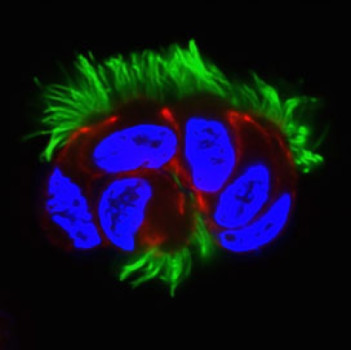
A small freshwater fish found in many tropical aquariums may hold the key to unlocking one of the leading causes of respiratory diseases in humans.
Scientists from A*STAR’s Institute of Molecular and Cell Biology (IMCB) have identified hundreds of novel genes in the zebrafish that could be functionally identical to the human genes required for forming motile cilia, hair-like structures on the surface of airway cells. These are required for removing dust and pathogens from the human airway. The study showed that the loss of these genes is linked to development of defective motile cilia, which could be the cause of some respiratory diseases.
Primary Ciliary Dyskinesia (PCD) is a rare genetic disorder which results in defective motile cilia within the human airway. Defective motile cilia cannot function properly to remove dust and bacteria from the lungs, leading to a range of respiratory problems, including chronic lung infections such as bronchitis and pneumonia, and in more severe cases, causes long term damage to the airway.
Reported recently as a cover article in Development, a research journal in developmental biology, the IMCB research team identified hundreds of novel genes that are associated with the development of motile cilia via genetic screening[1] in zebrafish. Out of nearly 600 genes found in the zebrafish, the researchers identified almost all of the 26 known genes responsible for PCD, implying that many more could be linked to the disorder.
Further studies on this discovery can yield useful information to pinpoint the genes associated with PCD. These genes may be valuable markers for the accurate diagnosis of PCD and other causes for defective motile cilia via genetic testing. This will in turn allow healthcare practitioners to implement mitigation strategies early.
“There is no cure for PCD. Doctors can only prescribe aggressive treatments to slow the progress of airway damage and address the respiratory issues resulting from PCD. It is therefore important to identify the genes responsible in a precise manner and diagnose the condition early,” said Dr Sudipto Roy, Senior Principal Investigator at IMCB and the lead scientist for the study. “Our collection of genes will be invaluable for understanding how cilia are made and what cause them to be defective. They are important clues for understanding cilia-related diseases, and to develop future treatments,” he added.
Professor Hong Wanjin, Executive Director of IMCB, said, “Developmental biology seeks to understand the basic principles governing the development of humans and how the emergence of complexities can be implicated in human diseases. This is exemplified in our study, which has uncovered the links between human diseases and the genes involved in cilia formation. Such foundational research is crucial as practical applications of research outcomes need to be grounded in fundamental science.”
Story Source:
The above story is based on materials provided by A*Star Agency for Science, Technology and Research. Note: Materials may be edited for content and length.
Journal Reference:
- S. P. Choksi, D. Babu, D. Lau, X. Yu, S. Roy. Systematic discovery of novel ciliary genes through functional genomics in the zebrafish. Development, 2014; 141 (17): 3410 DOI: 10.1242/dev.108209
